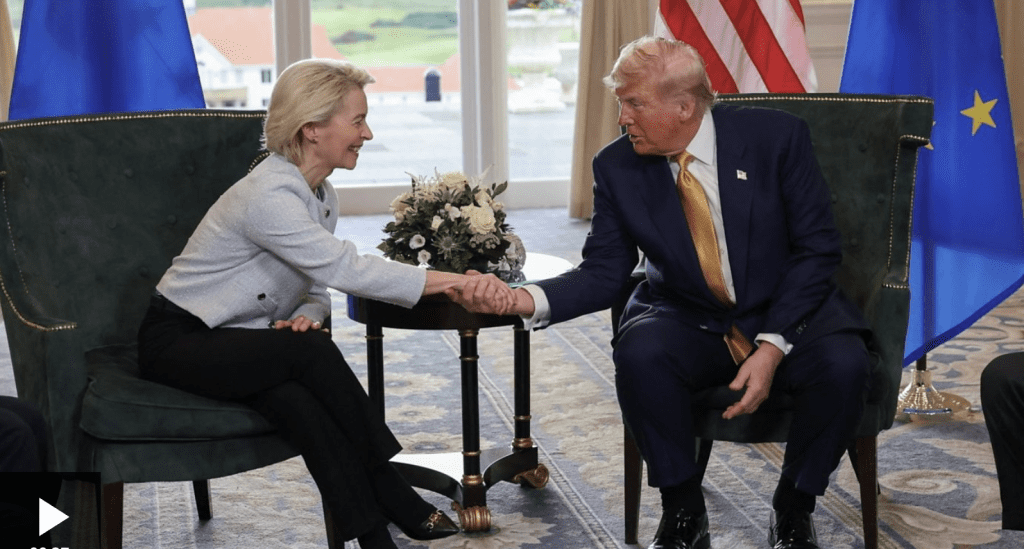Cliff Notes – US and EU reach trade deal to avoid tariffs
- The US and EU have agreed on a trade deal imposing a 15% tariff on goods, averting a potential 30% tariff threatened by Trump.
- The agreement includes a significant energy purchase from the US by the EU, aimed at enhancing energy security and diversifying supply sources.
What does the US and EU trade deal mean? Are we now dependent on the US more than ever?
The United States and the European Union on Sunday reached a trade deal, ending a months-long standoff. But what does the US and EU trade deal mean?
“We have reached a deal. It’s a good deal for everybody,” US President Donald Trump told reporters after talks with the European Commission President Ursula von der Leyen in Scotland.
“We have a trade deal between the two largest economies in the world. And it’s a big deal. It’s a huge deal,” said von der Leyen, who was seeking to finalise an agreement with Washington before the August 1 deadline.
“It will bring stability, it will bring predictability. That’s very important for businesses on both sides of the Atlantic,” she added.
Ahead of the crunch talks, Trump gave “a good 50-50 chance” on Friday for a deal to be reached with the European Union.
What’s in the EU-US trade deal?
“We are agreeing that the tariff straight across, for automobiles and everything else, will be a straight across tariff of 15%,” according to Trump. Currently, most EU goods face a 10% tariff, with levies of 25% on cars and car parts.
But the rate would not apply to steel and aluminium, which are being taxed at 50%.
Trump also said the bloc had agreed to purchase “$750 billion (€638 billion) worth of energy” from the US, as well as $600 billion more in additional investments.
“Purchases of US energy products will diversify our sources of supply and contribute to Europe’s energy security. We will replace Russian gas and oil by significant purchases of US LNG, oil and nuclear fuels,” von der Leyen told reporters.
She added that the baseline tariff rate of 15% on imported EU goods would apply to cars, semiconductors and pharmaceutical goods.
At the start of the meeting, Trump said that “fairness” was the main remaining sticking point.
“Europe is very closed. We don’t sell cars into Europe. We don’t sell essentially agriculture of any great degree,” he said.
What does the trade deal mean for the EU?
The trade pact means the bloc would avoid the 30% tariffs that Trump had threatened on all goods from the EU on July 12.
The 15% rate is the same as the one announced with Japan earlier this week. But it marks a significant compromise, especially given that von der Leyen offered a “zero-for-zero tariffs for industrial goods” when talks began.
Still, the EU chief said they agreed “zero-for-zero tariffs on a number of strategic products” including aircraft and aircraft parts, some chemicals, and certain agricultural products.
She added that the framework trade deal did not contain any decision regarding the spirits sector.
The trade pact will need to be approved by all 27 member states. But it does seem like a deal has been made more for the headlines than the negotiations that should have been had.
How have EU leaders reacted?
German Chancellor Friedrich Merz welcomed the trade deal following the announcement.
“We managed to avert a trade conflict that would have hit the export-oriented German economy hard,” Merz posted on X.


